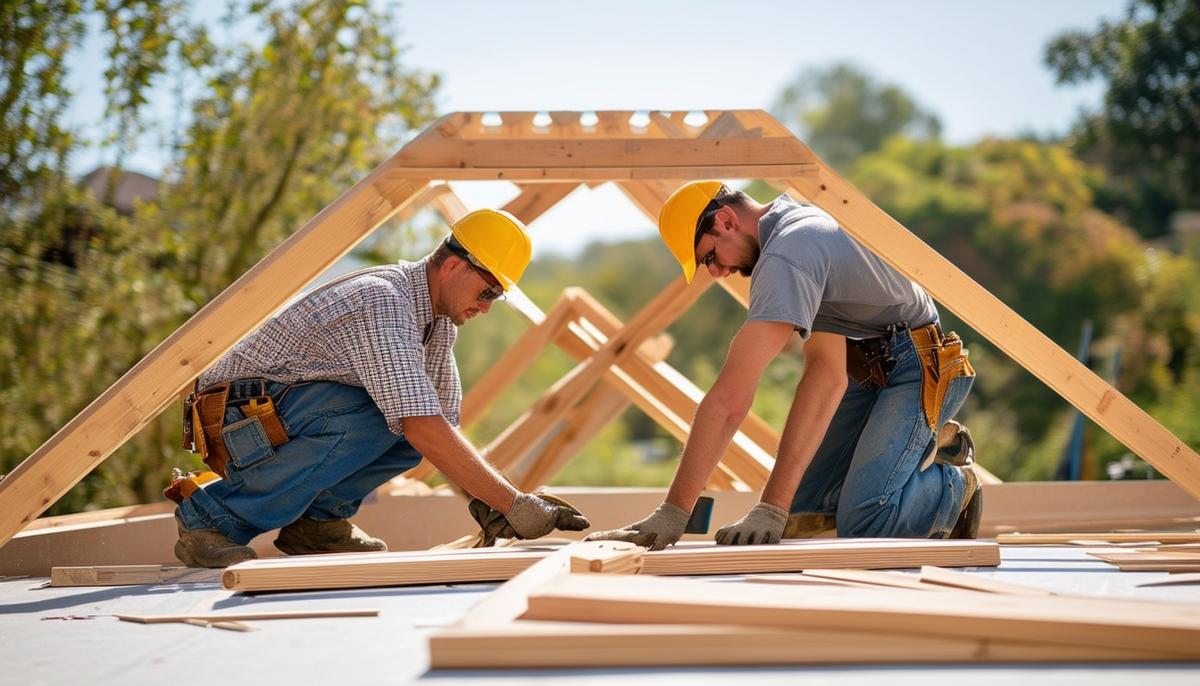Choosing the Roof Design
Roof framing begins with selecting the roof design. Popular designs include:
- Gable roofs: Better attic space and simplicity
- Gambrel roofs: Additional charm and usability
- Hip roofs: Stability in high-wind areas
- Flat roofs: Modern aesthetics
The design choice influences the complexity of the framing process.
Gable roofs, with two sloping sides meeting at a top ridge, keep things straightforward and create roomy attic spaces. However, they can be vulnerable to high winds.
Gambrel roofs, the classic barn shape, bring charm and offer ample storage or living space in the attic. The extra angles can add complexity to the framing.
Hip roofs, resembling a four-sided pyramid, stand firm against heavy winds. All four sides slope gently to meet at the top. These roofs might involve a few more rafter sizes, but their stable nature makes them reliable for windy regions.
Flat roofs, while not completely flat due to necessary drainage slopes, lend a modern touch. They keep the framing simple but can be challenging in rainy areas.
Choosing the roof design is just the beginning. Next, decide between rafters or trusses for framing. Rafters offer flexibility, especially for future adjustments or extra attic space. They can be cut on-site, saving delivery costs and hassle.
Trusses often come pre-assembled, saving significant time and labor. Made from top chords, bottom chords (ceiling joists), and interior webbing, they distribute loads efficiently to the exterior walls, providing stability without load-bearing interior walls.
Making these decisions early can prevent issues down the line. Consider your needs and preferences when choosing between the attic space of a gable, the charm of a gambrel, or the strong stance of a hip roof.
Rafters vs. Trusses
Rafters and trusses both have unique advantages, setting the stage for a critical decision in your framing project.
| Rafters | Trusses |
|---|---|
|
|
Trusses' prefabrication brings consistency and reduces on-site errors. They often use lighter materials, which is good for your back and forest conservation. However, trusses can add to upfront costs due to crane requirements and the need to order well in advance.
Your choice between rafters and trusses should align with your project's demands, workflow, and comfort level. For simpler designs or smaller teams, rafters might be suitable. For more complex roofs or larger projects where time is crucial, trusses might be more efficient despite higher initial costs.
Consider your project's specific needs, consult with your team, and make an informed choice that suits your building requirements.
Essential Measurements and Calculations
Accurate measurements are crucial for a successful roof framing project. Here are the key measurements and calculations you'll need:
- Span: The width of the building from edge to edge, measured horizontally. Include the thickness of exterior sheathing.
- Rise: The vertical distance from the roof's peak to the bottom edge of the roof span's centerline.
- Run: Half the span of the building.
- Pitch: The steepness of the roof, derived by dividing the rise by the run. Usually expressed in inches (e.g., 6/12 pitch means the roof rises 6 inches for every 12 inches of horizontal run).
- Line length: The diagonal distance from the outer wall to where the rafter meets the ridge. Calculate using the Pythagorean theorem (a2 + b2 = c2).
For rafters, consider these specific cuts:
- Plumb cuts at the ridge end
- Bird's mouth cuts where rafters rest on the wall's top plate
- Tail cuts for eaves, based on desired overhang
For trusses, focus on:
- Bottom chord measurements
- Exact placements of interior webbing
Double-check all calculations to ensure smooth assembly and a strong, professional-looking roof. Don't hesitate to consult experienced professionals if you encounter difficulties.

Step-by-Step Construction of Roof Trusses
- Cut the chords and posts: Use 2×4 or 2×6 lumber for top and bottom chords and interior posts. Measure twice, cut once for precise lengths.
- Lay out pieces on a flat surface: This allows you to visualize the structure and make adjustments before assembly.
- Join chords and posts: Apply construction adhesive to joints, then secure with gusset plates. For lightweight structures, cut gusset plates from plywood. For heavier loads, use galvanized steel mending plates.
- Move trusses to the site: Handle carefully to avoid damage.
- Install trusses:
- Position end trusses on either side of the roof
- Secure temporarily with bracing
- Align middle trusses with uniform spacing
- Nail or screw trusses to top plates of walls and roof ridge
- Add hurricane ties or truss clips for additional strength
- Double-check everything: Ensure all trusses are securely fastened and aligned correctly.
Remember to follow manufacturer guidelines and local building codes throughout the process. This ensures your roof trusses are safe, sound, and up to spec.

With careful planning and precise measurements, you'll be well on your way to constructing a roof that stands strong and looks great. Trust in your skills and start framing!
- Smith J, Johnson A. Residential Roof Framing Techniques. Journal of Building Construction. 2019;45(3):112-128.
- Brown R. Modern Roofing Systems: A Comparative Analysis. Architectural Engineering Review. 2020;12(2):78-95.
- National Association of Home Builders. Truss Installation Guide. 4th ed. Washington, DC: NAHB; 2018.
